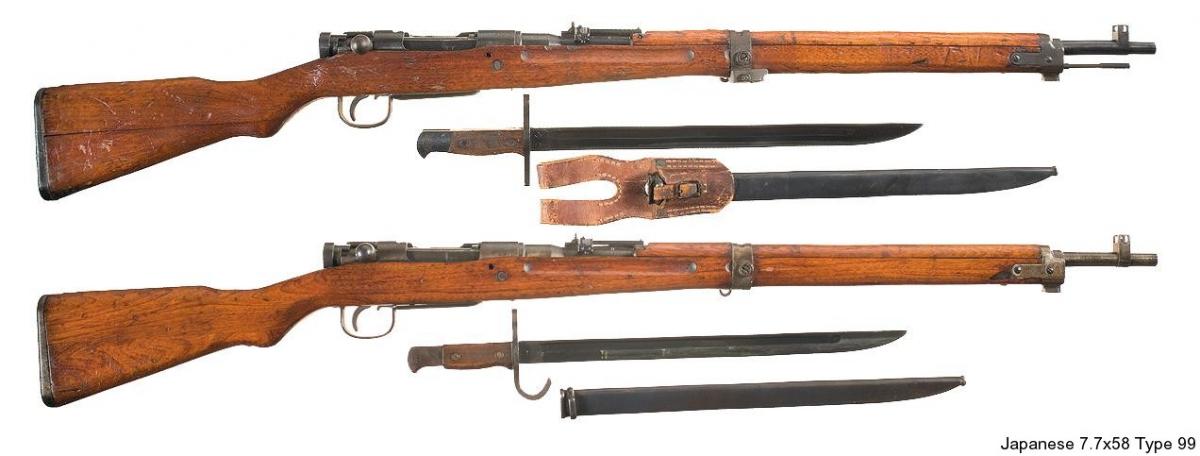
The official Japanese service rifle was the 6.5×50 Type 30 that was adopted in 1897, right after the First Sino-Japanese War (25 July 1894 – 17 April 1895). This was in the move towards smokeless powder and the Type 30 was eventually replaced by the Type 38 in 1905, the actual title of the gun “Type 38” came from the fact that it was adopted in the 38th year of the reign of the Meiji Emperor. As time progressed, the Japanese found out that they were under-gunned in many departments with the 6.5 Arisaka. During the 1920’s they started experimenting with the 7.7x56R, which is nothing more than the Japanese version of the .303 British that was adopted by the Imperial Japanese Navy. During 1929 the Japanese Airforce developed a semi-rimmed version of the 7.7x56R but with a 2mm longer case. This cartridge was adopted by them in 1932, and was considered an ‘improvement’ over the Navy version for better extraction in machine guns. This cartridge was designated 7.7x58SR Type 89.
In 1932, the Type 92 cartridge was developed for the Japanese Army’s new land service machine-gun, using the same semi-rimmed case as the Type 89. This allowed the ammunition to be used in the Type 89, flexible/ fixed machine-guns and the Type 92 heavy machine-gun. It also allowed a range of special loads for both the Type 89 and the Type 92 to be used. These different loads required special markings, adopting a system of colored lacquer case mouth seals. The 7.7x58SR T92 was not interchangeable with the 7.7x56R Navy version.
The Japanese Army also still utilised the 6,5 Arisaka as well and they had some eye watering experiences during the Second Sino-Japanese War in 1937 when they encountered the business end of the German 7.9×57 in China. This lead to the introduction of the 7.7×58 T99, during 1939, which was a rimless version of the T92 cartridge. The Japanese entered WW2 with three different 7.7mm cartridges – with the T99 being interchangeable with the T92, but not vice versa, and the Navy with their 303 version. It had to suck being a Japanese ordnance supply officer!
The types of 7.7×58 rimless T99 ammunition utilized the same case mouth seals as the 7.7x58SR:
Ball – Pink
Armor Piercing – Black
Tracer – Green
Explosive – Purple
Incendiary – Red




These marks are attributed to the Tokyo Army Arsenal but the meaning seems to be a source of speculation. In Ken Elks’ book, Volume 1, p62, “Japanese Ammunition 1880-1945,” he theorizes that these could be experimental rounds, with the headstamps marked for that reason, since he describes the differences between these rounds and the normal, unheadstamped versions as “very slight, almost undetectable in a casual inspection.” It has not been conclusively proven or disproven, so I would assume this topic is still open for discussion.






1. Tokyo Army Arsenal (reported experimental)
2. Ordinary Rifle load.
3. Steel dummy
4. Brass dummy
5. Rifle
6. Machine Gun.
The streamlined bullet is the machine gun load, whereas the specimens with the more rounded ogive are the rifle loads.
T99 Ball versions with brass and steel cases. Bullets are all non-magnetic








According to Ken Elks’ booklets on Japanese ammunition, the blackened bullets are a rare variation on the standard ball round. It is believed to be a treatment to prevent steel-jacketed bullets from rusting.


Steel cased dummy


Dummy – Brass


Incendiary Mod. Ma 101 High Explosive


The HE Projectile was made of Two Jackets, the inner containing the lead core, with the space between the inner jacket and the outer jacket was filled with RDX and later, picric acid, which exploded on compression between the two jackets on hitting a target. The purple lacquer was used on both the primer annulus, and the neck seal. It can be recognized by the flat meplat instead of a pointed bullet. The meplat is about 1/10th inch across.
Short range training




Blank






Dummy


Commercial manufacture

 Firearms Unlimited – made from recycled 30-06 cases (TW 45) in this case, which can still be observed on the headstamp.
Firearms Unlimited – made from recycled 30-06 cases (TW 45) in this case, which can still be observed on the headstamp.







